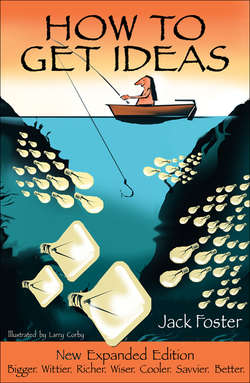Читать книгу How to Get Ideas - Jack Foster - Страница 4
На сайте Литреса книга снята с продажи.
Introduction
ОглавлениеWhat Is an Idea?
I know the answer. The answer lies within the heart of all mankind! What, the answer is twelve? I think I’m in the wrong building.
Charles Schultz
I was gratified to be able to answer promptly, and I did. I said I didn’t know.
Mark Twain
If love is the answer, could you please rephrase the question?
Lily Tomlin
Before we figure out how to get ideas we must discuss what ideas are, for if we don’t know what things are it’s difficult to figure out how to get more of them.
The only trouble is: How do you define an idea?
A. E. Housman said: “I could no more define poetry than a terrier can define a rat, but both of us recognize the object by the symptoms which it produces in us.” Beauty is like that too. So are things like quality and love.
And so, of course, is an idea. When we’re in the presence of one we know it, we feel it; something inside us recognizes it. But just try to define one.
Look in dictionaries and you’ll find everything from: “That which exists in the mind, potentially or actually, as a product of mental activity, such as a thought or knowledge,” to “The highest category: the complete and final product of reason,” to “A transcendent entity that is a real pattern of which existing things are imperfect representations.”
A lot of good that does you.
The difficulty is stated perfectly by Marvin Minsky in The Society of Mind:
Only in logic and mathematics do definitions ever capture concepts perfectly. … You can know what a tiger is without defining it. You may define a tiger, yet know scarcely anything about it.
If you ask people for a definition, however, you get better answers, answers that come pretty close to capturing both the concept and the thing itself.
Here are some answers I got from my coworkers and from my students at the University of Southern California and the University of California at Los Angeles:
It’s something that’s so obvious that after someone tells you about it you wonder why you didn’t think of it yourself.
An idea encompasses all aspects of a situation and makes it simple. It ties up all the loose ends into one neat knot. That knot is called an idea.
It is an immediately understood representation of something universally known or accepted, but conveyed in a novel, unique, or unexpected way.
Something new that can’t be seen from what preceded it.
It’s that flash of insight that lets you see things in a new light, that unites two seemingly disparate thoughts into one new concept.
An idea synthesizes the complex into the startlingly simple.
It seems to me that these definitions (actually, they’re more descriptions than definitions, but no matter – they get to the essence of it) give you a better feel for this elusive thing called an idea, for they talk about synthesis and problems and insights and obviousness.
The one that I like the best, though, and the one that is the basis of this book, is this one from James Webb Young:
An idea is nothing more nor less than a new combination of old elements.
There are two reasons I like it so much.
First, it practically tells you how to get an idea for it says that getting an idea is like creating a recipe for a new dish. All you have to do is take some ingredients you already know about and combine them in a new way. It’s as simple as that.
Not only is it simple, it doesn’t take a genius to do it. Nor does it take a rocket scientist or a Nobel Prize winner or a world-famous artist or a poet laureate or an advertising hotshot or a Pulitzer Prize winner or a first-class inventor.
“To my mind,” wrote the scientist and philosopher Jacob Bronowski, “it is a mistake to think of creative activity as something unusual.”
Ordinary people get good ideas everyday. Every day they create and invent and discover things. Every day they figure out different ways to repair cars and sinks and doors, to fix dinners, to increase sales, to save money, to teach their children, to reduce costs, to increase production, to write memos and proposals, to make things better or easier or cheaper – the list goes on and on.
Second, I like it because it zeros in on what I believe is the key to getting ideas, namely, combining things. Indeed, everything I’ve ever read about ideas talks about combining or linkage or juxtaposition or synthesis or association.
“It is obvious,” wrote Jacques Hadamard, “that invention or discovery, be it in mathematics or anywhere else, takes place by combining ideas… The Latin verb cogito, for ‘to think,’ etymologically means ‘to shake together.’ St. Augustine had already noticed that and had observed that intelligo means ‘to select among.’”
“When a poet’s mind is perfectly equipped for its work,” wrote T. S. Eliot, “it is constantly amalgamating disparate experiences. The ordinary man’s experience is chaotic, irregular, fragmentary. The latter falls in love or reads Spinoza, and these two experiences have nothing to do with each other, or with the noise of the typewriter or the smell of cooking; in the mind of the poet these experiences are always forming new wholes.”
“A man becomes creative,” wrote Bronowski, “whether he is an artist or a scientist, when he finds a new unity in the variety of nature. He does so by finding a likeness between things which were not thought alike before. … The creative mind is a mind that looks for unexpected likenesses.”
Or listen to Robert Frost: “What is an idea? If you remember only one thing I’ve said, remember that an idea is a feat of association.”
